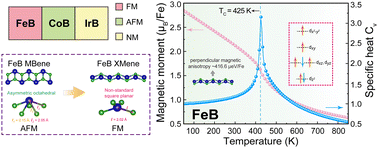Enriching 2D transition metal borides via MB XMenes (M = Fe, Co, Ir): Strong correlation and magnetism†
Abstract
Recently, two-dimensional (2D) FeSe-like anti-MXenes (or XMenes), composed of late d-block transition metal M and p-block nonmetal X elements, have been both experimentally and theoretically investigated. Here, we select three 2D borides FeB, CoB and IrB for a deeper investigation by including strong correlation effects, as a fertile ground for understanding and applications. Using a combination of Hubbard corrected first-principles calculations and Monte Carlo simulations, FeB and CoB are found to be ferro- and anti-ferro magnetic, contrasting with the non-magnetic nature of IrB. The metallic FeB XMene monolayer, superior to most of the MXenes or MBenes, exhibits robust ferromagnetism, driven by intertwined direct-exchange and super-exchange interactions between adjacent Fe atoms. The predicted Curie temperature (TC) of the FeB monolayer via the Heisenberg model reaches an impressive 425 K, with the easy-axis oriented out-of-plane and high magnetic anisotropic energy (MAE). The asymmetry in the spin-resolved transmission spectrum induces a thermal spin current, providing an opportunity for spin filtration. This novel 2D FeB material is expected to hold great promise as an information storage medium and find applications in emerging spintronic devices.



 Please wait while we load your content...
Please wait while we load your content...